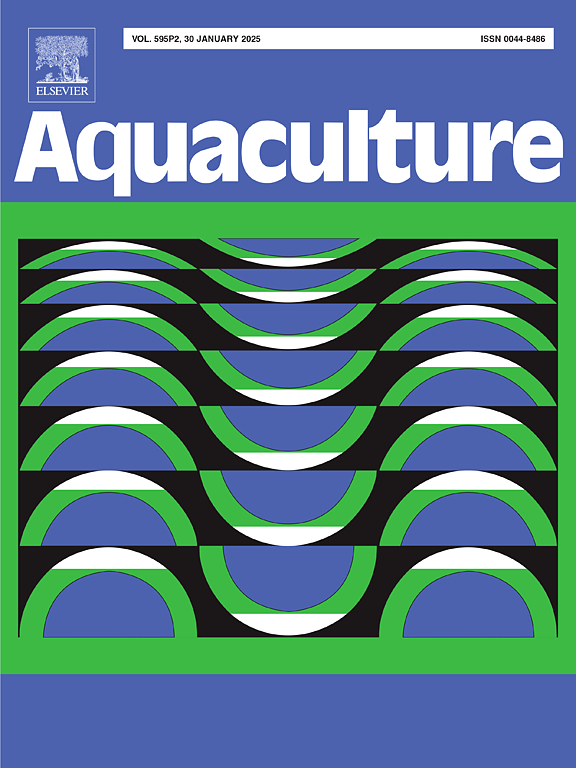Growth performances of gilthead seabream (Sparus aurata) fed alternative diets for “circular” land-based IMTA production
IF 3.9
1区 农林科学
Q1 FISHERIES
引用次数: 0
Abstract
Developing alternative and sustainable fish diets and alternative farming systems such as the SIMTAP (Self-sufficient Integrated Multi-Trophic AquaPonic) system, are possible strategies to improve aquaculture sustainability. In the present study, three consecutive trials were carried out on gilthead seabream (Sparus aurata), aiming to develop possible sustainable diets to be used within an Integrated MultiTrophic Aquaculture or SIMTAP systems (www.simtap.eu). The three tested diets consisted mainly of detritivores and/or filter-feeders organisms (on dry matter basis): M1) 50 % mussels (Mytilus platensis) and 50 % clams (Chamelea galina) used in the Experiment 1 (initial fish body weight 6.78 g); M2) 50 % mussels, 30 % clams (C. galina), and 20 % polychaetes (Nereis virens), used in the Experiment 2 (initial fish body weight 37.21 g); M3) 49 % mussels, 30 % clams (Paphia textile), 20 % polychaetes (N. virens), and 1 % of mineral premix, used in the Experiment 3 (initial fish body weight 249.17 g).
In both Experiments 1 and 2, the groups fed the experimental diets showed lower growth performances than the groups fed the commercial feeds, notably for final body weight and specific growth rate. On the contrary, when the same mineral mix included in the commercial feed was added to the experimental diet (diet M3, Experiment 3), the fish fed the alternative diet (M3) showed better Body Weight gain (101.54 ± 2.016 vs 84.18 ± 2.478) and Specific Growth Rate (0.55 ± 0.009 vs 0.44 ± 0.014), among others. Moreover, in the Experiments 1 and 2 the groups fed the alternative diets showed a better viscerosomatic index, while in the Experiment 3 both viscerosomatic (5.76 ± 0.146 vs 6.37 ± 0.235) and hepatosomatic (1.94 ± 0.053 vs 2.37 ± 0.086) index were improved significantly. In conclusion, the experimental diets may improve the growth performances of gilthead seabream, when a proper mineral dietary integration is considered. Finally, new studies should be carried out for further optimize nutritional traits of the diets alternative to commercial feeds, and properly assess their sustainability.
“循环”陆基IMTA生产替代饲料对黄颡鱼生长性能的影响
开发替代和可持续的鱼类饲料和替代养殖系统,如SIMTAP(自给自足综合多营养水共生)系统,是提高水产养殖可持续性的可能战略。在本研究中,对黄颡鱼(Sparus aurata)进行了三次连续试验,旨在开发可用于综合多营养水产养殖或SIMTAP系统的可持续饲料(www.simtap.eu)。三种试验饲料主要由营养动物和/或滤食性生物(以干物质为基础)组成:M1)试验1中使用的50%贻贝(Mytilus platensis)和50%蛤(Chamelea galina)(初始鱼重6.78 g);M2) 50%贻贝,30%蛤蜊(C. galina), 20%多毛动物(Nereis virens),试验2(初始鱼重37.21 g);M3) 49%的贻贝,30%的蛤(帕菲亚纺织品),20%的多毛类(N. virens)和1%的矿物预混料,用于实验3(鱼的初始体重249.17 g)。在试验1和试验2中,试验组的生长性能均低于商品饲料组,尤其是末重和特定生长率。相反,在试验饲料(M3饲料,试验3)中添加与商品饲料中相同的矿物质混合物时,M3饲料的增重(101.54±2.016 vs 84.18±2.478)和特定生长率(0.55±0.009 vs 0.44±0.014)均优于商品饲料(M3饲料)。试验1和试验2中,饲粮替代组的脏体指数较好,试验3中脏体指数(5.76±0.146 vs 6.37±0.235)和肝体指数(1.94±0.053 vs 2.37±0.086)均显著提高。综上所述,在试验饲粮中适当添加矿物质,可提高鳙鱼的生长性能。最后,应开展新的研究,进一步优化商品饲料替代日粮的营养性状,并适当评估其可持续性。
本文章由计算机程序翻译,如有差异,请以英文原文为准。
求助全文
约1分钟内获得全文
求助全文
来源期刊

Aquaculture
农林科学-海洋与淡水生物学
CiteScore
8.60
自引率
17.80%
发文量
1246
审稿时长
56 days
期刊介绍:
Aquaculture is an international journal for the exploration, improvement and management of all freshwater and marine food resources. It publishes novel and innovative research of world-wide interest on farming of aquatic organisms, which includes finfish, mollusks, crustaceans and aquatic plants for human consumption. Research on ornamentals is not a focus of the Journal. Aquaculture only publishes papers with a clear relevance to improving aquaculture practices or a potential application.
 求助内容:
求助内容: 应助结果提醒方式:
应助结果提醒方式:


